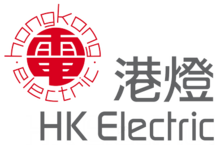Hongkong Electric Company
 |
|
| Industry | Public utility |
|---|---|
| Founded | 1 December 1890 |
| Headquarters | Hong Kong |
| Products | Electric service |
| Website | www |
The Hongkong Electric Company (HKC; Chinese: 香港電燈有限公司) is one of Hong Kong's two main electricity generation companies, the other being China Light & Power. The company is owned by several companies including Power Assets Holdings, Cheung Kong Infrastructure Holdings and Qatar Investment Authority. It was the first company to provide electricity in Hong Kong, having run continually since the 19th century.
Following a meeting of the Executive Council to discuss land reclamation, Bendyshe Layton suggested to Sir Catchick Paul Chater that Hong Kong acquire an electricity generator. Chater, who was to remain a director of the new Hong Kong Electric Company for 37 years, took charge of raising finance for the project. The total capital of $300,000 was divided into 30,000 shares, half of which were offered to the public. As a result, the first power station in Hong Kong was secretly built on the site of an old graveyard in Star Street, Wan Chai. The plant was designed by electrical engineer William Wickham who subsequently remained its manager until 1910. At 6:00 p.m. on 1 December 1890, 50 street lights along Queen's Road Central, Battery Path and Upper Albert Road were switched on. The lights failed on the second night then again one week later. Thereafter there were no further faults for 26 years. Street lighting was later extended west as far as Bonham Strand and Caine Road then later along Queens Road East and Wanchai Road to Mission Hospital Hill (site of the present Ruttonjee Hospital). In the 1890s, as electricity became popular, the first private houses were connected to the company's supply to power lights and fans. On the commercial front, a substation was built in 1898 to service the lifts of the new tall buildings mushrooming along the waterfront. By 1905 the company was supplying power for 15 lifts, thousands of lamps as well as for street lighting. The power grid was extended underground to West Point then later to Victoria Peak and Shau Kei Wan. By 1916, Aberdeen and Ap Lei Chau were also connected. One by one large organisations like Dairy farm, Taikoo Docks, the Peak Tram and the University of Hong Kong which had formerly generated their own supplies, switched to the company's supply. In 1924 there were 1,369 street lamps lit by gas with only 469 powered by electricity. However, by 1936, few gas lamps remained.
...
Wikipedia
